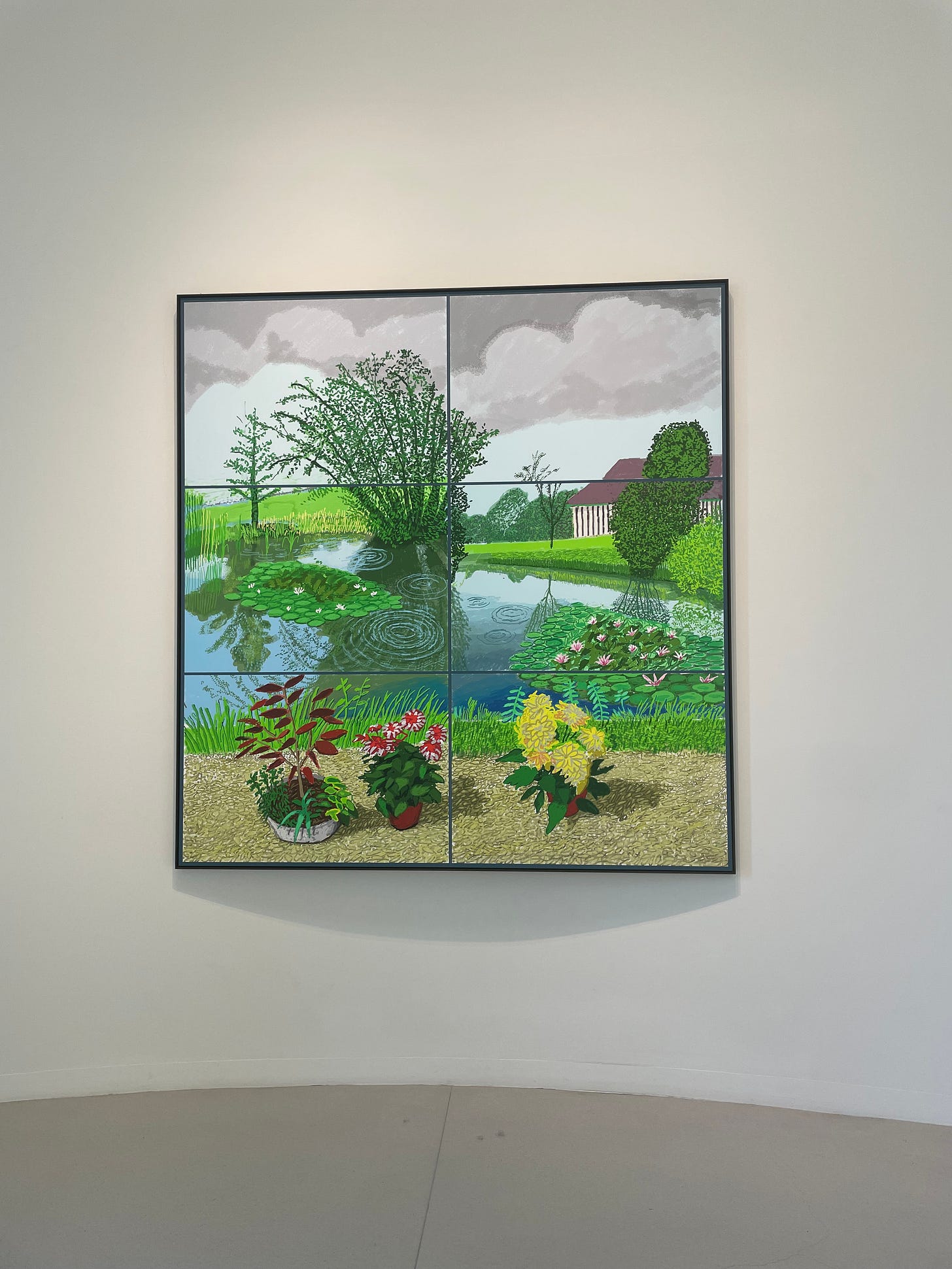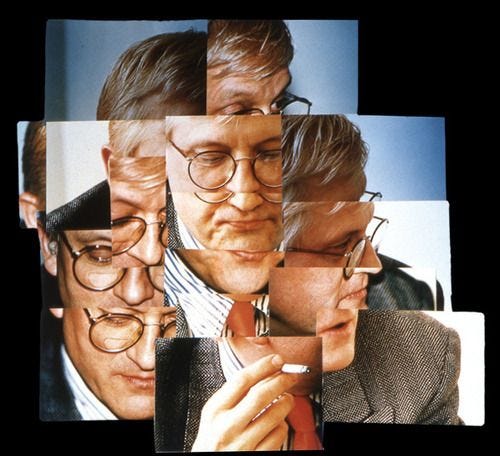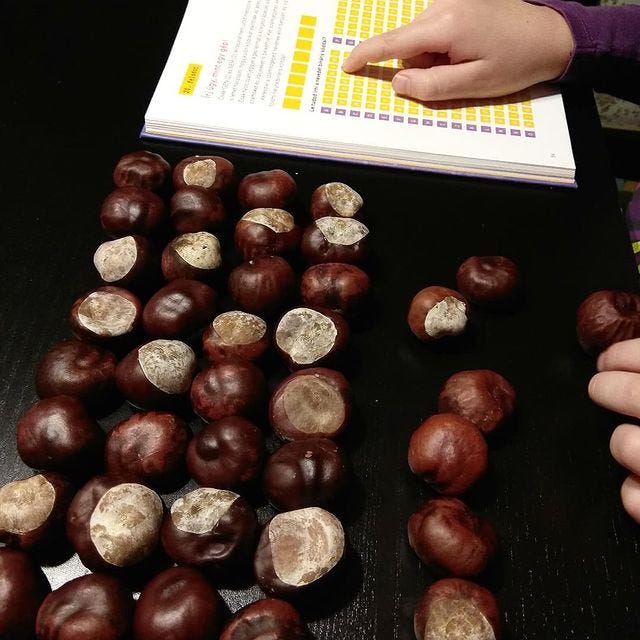No. 29 — David Hockney 👀 But to see like this 🐈 They All Saw a Cat
Living in a rectangular world
My name is Linda. I write a bi-weekly newsletter about computer science, childhood and culture - and there are 9628 of you listening. If you enjoy this issue, please share it with anyone you think may find it useful.
A few weeks ago I went to see the new David Hockney exhibition at musée de l'Orangerie. The show makes you walk a 70 meter demi-circle, following a year’s progress in Hockney’s surroundings in Normandy. Like a Chinese scroll, movement through time.
I am too much of an amateur in art to attempt to explain what David Hockney has been doing throughout his career. He has played with paint, crayons, photography, fax machines, camera obscuras and now with iPads to help us notice how technologies can enhance and change our perception. He has twisted perspectives and cut corners of paintings to help us notice how we see.
I think his interest in the lack of a single linear perspective and act of seeing are fascinating when trying to help children understand the world through the perspective of a machine. (Why? Because to understand the other, helps understand oneself.)
Of course I’ve been collecting examples of this non-human vision in technical ways. Examples include how a Roomba looks at the world, how a computer watches movies and what neural networks see? But I think David Hockney might still be my best guide in thinking about childhood and computer-aided perspectives to the world.


Some of the early Hockney photographic mosaics remind me of the recent explanations of how computers piece together visual information, in a way seemingly completely foreign to us. And at the same time, isn’t this exactly the way we see the world? As snapshots, from different perspectives, with progress of time built into our vision.
I don’t have a great activity to propose just yet to help children use the computer to see time, distance, non-linear perspective, escape the rectangle and notice perception. One idea I’ve been toying around with is the story recounted by Vea Vecchi in Art and Creativity in Reggio Emilia where children are divided into groups around the model, each with a different perspective.
One girl, Laura, wanders around and stops to speak to Martina, who is sitting at Sewaa’s side. Laura tells Martina that what she has done isn’t right. In a friendly way, she says, “You’ve drawn Sewaa as if she was like this, in front of you…. Instead you were supposed to draw her like this … from the side … in profile … with only one eye, only one leg, only one ear.” She shows Martina her own side-view drawing, putting them side by side to compare. Martina, at first surprised, seems little by little to understand what Laura is trying to show her. Marina, the teacher, comes close to Martina and says in a kindly way, “The drawing you have made is lovely.” She pauses, then goes on to say, “But, to see it like this, where would you have to be sitting?” Martina points to the groups who can see Sewaa from the side, “There, at that table there.”
What if the children could do the same, but instead of crayons, use the computer as a collaborator and co-drawer? What if instead of colors they could use datasets? What is instead of static images, they could use all the interactivity a computer can offer?
My dream collaboration would probably be a 5 year old, a Reggio Emilia atelierista, a computer vision researcher and Hockney spending a week together in Normandy.
Linked List
In computer science, a linked list is a linear collection of data elements whose order is not given by their physical placement in memory. But here it is a selection of things I’ve been reading lately.
Spring Cannot be Cancelled: David Hockney in Normandy by David Hockney and Martin Gaynor is by far my favorite book of the year. My favorite thing about the book is that while Hockney is getting older and his living environment is getting smaller, it feels like his curiosity and vigour for life are just getting bigger. It’s rare.
They All Saw A Cat looks like a picture book version of what I’m trying to explain here with words. How We See by What’s New deconstructs human vision in a scientific way, many parts of which were completely new for me.
If you frame it like that. A fascinating essay on art history, rectangles, squares and circles. Another thing Hockney has been obsessed for a long time is escaping the rectangle.
“It’s incredible how deeply imprinted we are with these damn rectangles”, Hockney commented as we looked at one of these early Grand Canyon collages on its cardboard panel. “Everything in our culture seems to reinforce the instinct to see rectangularly - books, streets, buildings, rooms, windows. Sam Francis once told me how odd the American Indian initially found the white settlers: ‘These people who insist on living in rectangular buildings.’ The Indians, you see, lived in a circular world.
- From True to Life: Twenty-Five Years of Conversations with David Hockney by Lawrence WeschlerMy friend Kristoffer launched a project called Wilderness Land : A Tribute to Web Surfing. It has a map, a Totoro and five hundred hidden links to odd, poetic places on the Internet. It too, defies rectangles.
Classroom
I’m hoping to surface and share stories from all of you and I’d love to see your creations! Here are a few teachers using Ruby in creative, fun and inspiring ways:
Binary practice with chestnuts! Worksheet version here.
I love the flappy computers! Printables here.


An A1 size poster by William Lau on all the splendid reading options around computer science, grouped by age and topic.







